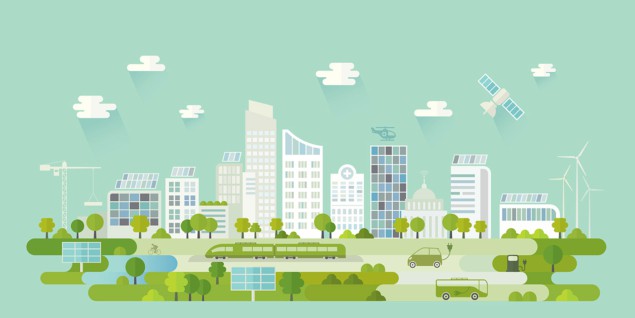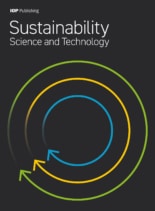Finding creative solutions to complex sustainability challenges requires input from diverse communities and stakeholders, argues the editor-in-chief of Sustainability Science and Technology

The ongoing drive towards more sustainable development, defined by the United Nations as meeting “the needs of the present without compromising the ability of the future to meet its needs”, manifests itself in many different ways. For scientists and engineers, it is most commonly translated into the pursuit of innovative technologies that aim to safeguard the future of our planet, such as cleaner sources of energy, manufacturing processes that minimize the use of toxic substances, or recycling and recovery schemes that make more efficient use of limited natural resources.
However, such a tight focus on the technology can ignore other factors that determine whether a novel solution is sustainable, which might include the cost of production and operation, the long-term availability of materials, and the social impact of introducing a new product or process. “Green technologies that are designed primarily to protect the environment are not always sustainable,” says Jonas Baltrusaitis, associate professor of chemical engineering at Lehigh University in Bethlehem, US, and the editor-in-chief of a new open-access journal, Sustainability Science and Technology, that has just been launched by IOP Publishing. “Sustainability demands a more comprehensive perspective that balances environmental, social and economic considerations, with the aim of creating enduring systems and practices that benefit both current and future generations.”
By way of example, Baltrusaitis explains how the distinction applies to building design. “A green building might incorporate energy-saving technologies, use recycled materials, and implement efficient water management systems,” he says. “Such measures are undoubtedly positive steps toward environmental conservation, but they might not be sustainable if they do not consider the long-term social and economic impacts of the building’s construction and operation.”
Baltrusaitis argues that most scientific discourse, as represented in the growing number of journals within the field of sustainability, tends to overlook the complex factors that determine whether a novel technology will deliver an effective and workable solution that will have a positive impact both now and in the future. “Existing journals focus all their attention on the technology, since pretty much any scientific or engineering discipline can demonstrate some level of progress towards sustainability,” he says. “With this new journal we want to consider the development of innovative technologies within a broader social and economic context, rather than just glorifying the technology itself.”
Indeed, various scientific approaches have been developed to determine whether or not a new product, process or technology can drive sustainable change. Perhaps best known is life-cycle assessment, which evaluates the environmental impacts of a product or process throughout its lifetime, from the initial extraction of raw materials through to routine operation and its eventual disposal. Other methodologies have been developed to provide quantifiable measures of a technology’s ecological footprint, socio-economic impact, and use of energy and resources, while decision-making analysis offers a way to combine multiple criteria for an objective comparison of alternative solutions.

“We want to encourage submissions that might, for example, analyse the long-term value of the products, technologies or processes being created, or assess their benefit or detriment to people and local communities,” says Baltrusaitis. “Our aim for the journal is to offer equitable publishing that represents all three pillars of sustainability – social, environmental and economic – as they relate to the development of novel technologies and processes.”
Taking such a holistic approach to the intricate and interconnected challenges of sustainability will require engagement between different disciplines and stakeholder communities. “We want to provide a platform for scholars, researchers, and experts from diverse fields to collaborate and share their findings,” continues Baltrusaitis. “The development of sustainable solutions across various areas of science and technology offers a rich opportunity for interdisciplinary learning, allowing different communities to benefit from innovative approaches and methodologies developed in other fields.”
As an example, says Baltrusaitis, sustainable energy solutions developed in the engineering sector can inspire new ideas in agriculture or urban planning. “This exchange of knowledge helps to avoid redundant efforts and accelerate progress toward a more sustainable future,” he says. “Bringing together diverse ideas can also spark creativity, leading to the development of cross-disciplinary solutions that address complex sustainability challenges.”
Such collaborative efforts will need to combine the scientific expertise of the research community with the real-world experience offered by policymakers, industry leaders and local organizations. That interplay between sustainable technology development and public policy can clearly be seen, for instance, in the adoption rates of electric vehicles around the world. While technology improvements have helped to expand the global fleet of electric vehicles to 14% of all new cars sold in 2022, concerted government action in Norway – which includes financial incentives for motorists, co-ordinated investment in charging infrastructure, and a long-standing commitment to ban sales of new fossil-fuel cars by 2025 – has boosted that figure to almost 80%.
“Collaborations between the scientific community and other key stakeholders are pivotal in driving sustainable change,” says Baltrusaitis. “Partnering with policymakers can help scientists to understand real-world pressures that can guide research toward practical solutions, while innovative collaborations between scientists and business can facilitate the development of sustainable technologies and practices. We want the journal to showcase successful partnerships, share best practice, and inspire and inform readers about effective development strategies.”
Establishing this type of cross-disciplinary forum will require an innovative publishing approach. While the journal will be centred around traditional scientific articles that present significant technical advances, the aim is to offer different publishing options that reflect the wider ethos of sustainability, such as proof-of-concept demonstrations, life-cycle assessments, and roadmaps that assess economic and social factors alongside the development of novel technologies. “As the journal evolves we will find better ways to include these important contributions,” comments Baltrusaitis.
One common aspect across all the studies published in the journal will be a strong connection to one or more of the UN’s 17 sustainable development goals (SDGs). These interlinked objectives are designed to provide a “shared blueprint for peace and prosperity for people and the planet, now and into the future”, and many have a clear technological component – such as clean water and sanitation, climate action, affordable and clean energy, and responsible consumption and production. Reflecting the broad themes of the SDGs, the subject scope for the journal spans everything from carbon capture and storage through to sustainable chemistry, waste reduction and recycling, and water management.
Within these wide-ranging areas it will be particularly important for the journal to reflect global sustainability initiatives, since the priorities for research and action are likely to depend on regional needs and concerns. Indeed, a UN-supported study published in 2022 showed that some 64% of research publications from low-income countries are aligned with the SDGs, compared to just 34% in high-income nations that are likely to have the largest budgets for academic research. “We want to represent all geographic locations and all disciplines through the editorial board and through the work that we showcase in the journal,” says Baltrusaitis. “Collaborative efforts within the global scientific community will be essential to identify and prioritize initiatives that will have the most positive impact on the future of the planet.”
- Sustainability Science and Technology is a new open-access journal from IOP Publishing, which also publishes Physics World. The journal opens for submissions in January 2024, with all publication charges waived until the end of 2026.
- SEO Powered Content & PR Distribution. Get Amplified Today.
- PlatoData.Network Vertical Generative Ai. Empower Yourself. Access Here.
- PlatoAiStream. Web3 Intelligence. Knowledge Amplified. Access Here.
- PlatoESG. Carbon, CleanTech, Energy, Environment, Solar, Waste Management. Access Here.
- PlatoHealth. Biotech and Clinical Trials Intelligence. Access Here.
- Source: https://physicsworld.com/a/sustainable-success-demands-joined-up-thinking/
- :has
- :is
- :not
- 17
- 200
- 2022
- 2024
- 2025
- 2026
- a
- ability
- About
- academic
- academic research
- accelerate
- across
- Action
- address
- Adoption
- advances
- affordable
- agriculture
- aim
- aligned
- All
- Allowing
- almost
- alongside
- also
- alternative
- always
- an
- analyse
- analysis
- and
- any
- applies
- approach
- approaches
- ARE
- areas
- Argues
- around
- articles
- AS
- aspect
- assess
- assessment
- assessments
- Associate
- At
- attention
- availability
- avoid
- balances
- Ban
- BE
- been
- being
- benefit
- BEST
- Better
- between
- blueprint
- board
- Boosted
- both
- broad
- broader
- Budgets
- Building
- business
- but
- by
- CAN
- capture
- carbon
- carbon capture
- cars
- challenges
- change
- changing
- charges
- charging
- chemical
- chemistry
- clean
- clean energy
- cleaner
- clear
- clearly
- click
- Climate
- climate action
- collaborate
- collaborations
- collaborative
- combine
- comments
- commitment
- Common
- commonly
- Communities
- community
- compared
- comparison
- complex
- component
- comprehensive
- compromising
- Concerns
- concerted
- connection
- CONSERVATION
- Consider
- considerations
- construction
- consumption
- context
- continues
- contributions
- Cost
- cost of production
- countries
- create
- created
- Creating
- Creative
- creativity
- criteria
- Current
- Decision Making
- defined
- deliver
- demands
- demonstrate
- depend
- Design
- designed
- Determine
- developed
- Development
- different
- discipline
- disciplines
- discourse
- disposal
- distinction
- diverse
- do
- drive
- driving
- Ecological
- Economic
- economic impacts
- editor-in-chief
- Editorial
- Effective
- efficient
- efforts
- Electric
- electric vehicles
- encourage
- end
- enduring
- energy
- Energy Solutions
- engagement
- Engineering
- Engineers
- Environment
- environmental
- equitable
- essential
- Ethos
- eventual
- everything
- evolves
- example
- exchange
- Expand
- experience
- expertise
- experts
- Explains
- extraction
- facilitate
- factors
- field
- Fields
- Figure
- financial
- Find
- findings
- FLEET
- Focus
- Footprint
- For
- Forum
- from
- future
- generations
- geographic
- Global
- Goals
- Government
- Green
- Growing
- guide
- Have
- he
- help
- helped
- helps
- holistic
- hopes
- How
- HTTPS
- ideas
- identify
- if
- ignore
- image
- Impact
- Impacts
- implement
- important
- improvements
- in
- In other
- Incentives
- include
- includes
- incorporate
- industry
- inform
- information
- Infrastructure
- initial
- initiatives
- innovative
- innovative technologies
- input
- inspire
- instance
- interconnected
- into
- intricate
- introducing
- investment
- issue
- IT
- ITS
- itself
- January
- journal
- jpg
- just
- Key
- knowledge
- known
- largest
- launched
- leaders
- leading
- learning
- Level
- life-cycle
- lifetime
- likely
- Limited
- local
- locations
- long-standing
- long-term
- make
- management
- manufacturing
- many
- materials
- max-width
- measures
- Meet
- meeting
- Meets
- methodologies
- might
- minimize
- more
- more efficient
- most
- much
- multiple
- Nations
- Natural
- Need
- needs
- New
- new product
- Norway
- novel
- now
- number
- objective
- objectives
- of
- offer
- offered
- Offers
- on
- ONE
- ongoing
- open
- opens
- operation
- Opportunity
- Options
- or
- organizations
- Other
- our
- particularly
- partnerships
- People
- perhaps
- perspective
- Physics
- Physics World
- pillars
- pivotal
- planet
- planning
- platform
- plato
- Plato Data Intelligence
- PlatoData
- policy
- policymakers
- positive
- Practical
- practice
- practices
- present
- pretty
- primarily
- Prioritize
- process
- processes
- Product
- Production
- Products
- Professor
- Progress
- prosper
- prosperity
- protect
- provide
- public
- Publication
- publications
- published
- Publishes
- Publishing
- pursuit
- quantifiable
- rapidly
- Rates
- rather
- Raw
- readers
- real world
- recovery
- recycled
- recycling
- reduction
- reflect
- reflecting
- regional
- represent
- represented
- represents
- require
- requires
- research
- Research Community
- researchers
- Resources
- responsible
- Rich
- roadmaps
- routine
- safeguarding
- sales
- says
- schemes
- Scholars
- Science
- Science and Technology
- scientific
- scientists
- scope
- SDGs
- sector
- Seeks
- seen
- Share
- showcase
- showed
- significant
- since
- Social
- Social impact
- sold
- solution
- Solutions
- some
- Sources
- spans
- Spark
- stakeholder
- stakeholders
- Steps
- storage
- strategies
- strong
- studies
- Study
- subject
- Submissions
- success
- successful
- such
- Sustainability
- sustainable
- Sustainable Development
- Sustainable Energy
- sustainable future
- Systems
- Technical
- technological
- Technologies
- Technology
- Technology Development
- tends
- than
- that
- The
- The Future
- the world
- their
- themes
- These
- they
- Thinking
- this
- three
- Thrive
- Through
- throughout
- thumbnail
- to
- together
- toward
- towards
- traditional
- type
- understand
- undoubtedly
- United
- united nations
- university
- until
- urban
- us
- use
- value
- various
- Vehicles
- waived
- want
- Waste
- Water
- Way..
- ways
- we
- whether
- which
- while
- wider
- will
- with
- within
- without
- Work
- world
- zephyrnet












